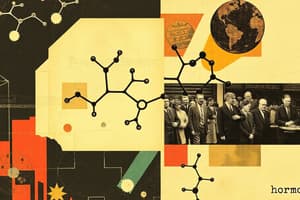Podcast
Questions and Answers
What occurs when a catecholamine or peptide hormone binds to its receptor on a cell surface?
What occurs when a catecholamine or peptide hormone binds to its receptor on a cell surface?
- Ion channels open directly without secondary messengers.
- A second messenger is generated in the cytoplasm. (correct)
- The hormone immediately alters gene transcription.
- A direct effect on DNA regulation occurs.
Which hormone is responsible for stimulating milk production in mammary glands?
Which hormone is responsible for stimulating milk production in mammary glands?
- Prolactin (correct)
- ACTH
- Somatotropin
- TSH
Which statement about peptide hormones is false?
Which statement about peptide hormones is false?
- They are synthesized as prohormones initially.
- They interact with surface receptors of target cells.
- They remain in circulation for long periods. (correct)
- Peptide hormones can be activated from prohormones.
Where are steroid hormones synthesized within the cell?
Where are steroid hormones synthesized within the cell?
Which hormone controls the release of glucocorticoids from the adrenal cortex?
Which hormone controls the release of glucocorticoids from the adrenal cortex?
Which of the following is NOT an amino acid-derived hormone?
Which of the following is NOT an amino acid-derived hormone?
What type of hormone is characterized as a lipophobic molecule interacting with surface receptors?
What type of hormone is characterized as a lipophobic molecule interacting with surface receptors?
Which of the following actions is NOT associated with steroid hormones?
Which of the following actions is NOT associated with steroid hormones?
Flashcards
Hormone
Hormone
A signaling molecule released by endocrine glands, acting on distant target cells. They regulate a wide range of physiological processes.
Peptide hormone
Peptide hormone
A hormone made up of amino acids, often acting through second messenger systems. Examples include insulin and glucagon.
Steroid hormone
Steroid hormone
A hormone derived from cholesterol, able to cross cell membranes and interact with intracellular receptors. Examples include testosterone and estrogen.
Method of hormone action
Method of hormone action
Signup and view all the flashcards
Second messenger
Second messenger
Signup and view all the flashcards
G protein
G protein
Signup and view all the flashcards
Hypothalamus
Hypothalamus
Signup and view all the flashcards
Posterior Pituitary
Posterior Pituitary
Signup and view all the flashcards
Study Notes
Hormone Action Mechanisms
- Hormones control various cellular processes, including electrical signaling, ion/molecule transport, enzyme activity, gene expression, and protein synthesis.
- Peptide hormones bind to cell surface receptors, triggering a second messenger system (often involving G proteins).
- Adenyl cyclase activation leads to cyclic AMP (cAMP) production.
- Steroid hormones bind to intracellular receptors, directly affecting gene transcription.
- Steroid hormones are synthesized in the smooth endoplasmic reticulum.
Hormone Types and Characteristics
-
Peptide hormones are predominantly lipophobic, interacting with cell surface receptors. They are typically synthesized as prohormones, then modified prior to release. They usually remain in circulation for a short time, and interact directly with receptors on the target cells' surfaces. Prohormones are activated before release via post-translational modification. They circulate in the bloodstream unbound to protein carriers.
-
Steroid hormones are lipophilic, binding to intracellular receptors. They cannot be stored in secretory vesicles.
-
Amino acid-derived hormones are synthesized from tyrosine. An example is thyroid hormone, epinephrine and norepinephrine, and melatonin
Endocrine Glands and Hormones
- Most hormones in the body are peptide hormones.
- The most complex endocrine responses start with the hypothalamus.
- The posterior pituitary secretes antidiuretic hormone (ADH, also known as vasopressin).
- The anterior pituitary is a true endocrine gland, of epithelial origin that releases numerous hormones.
- The pituitary hormone that regulates glucocorticoid release from the adrenal cortex is adrenocorticotropic hormone (ACTH).
- Thyroid-stimulating hormone (TSH) regulates thyroid hormone synthesis and release.
- Prolactin stimulates milk production in mammary glands.
- Somatotropin (growth hormone) stimulates cell growth and metabolism.
Matching Hormones with Descriptions
- Peptide hormone: Lipophobic molecule that interacts with receptors on cell surfaces.
- Steroid hormone: Cannot be stored in secretory vesicles.
- Amino acid-derived hormone: Derivatives of tyrosine.
- Anterior pituitary: True endocrine gland of epithelial origin.
- Hypothalamus: Site of vasopressin synthesis.
- Posterior pituitary: Storage and release site for oxytocin.
Studying That Suits You
Use AI to generate personalized quizzes and flashcards to suit your learning preferences.




